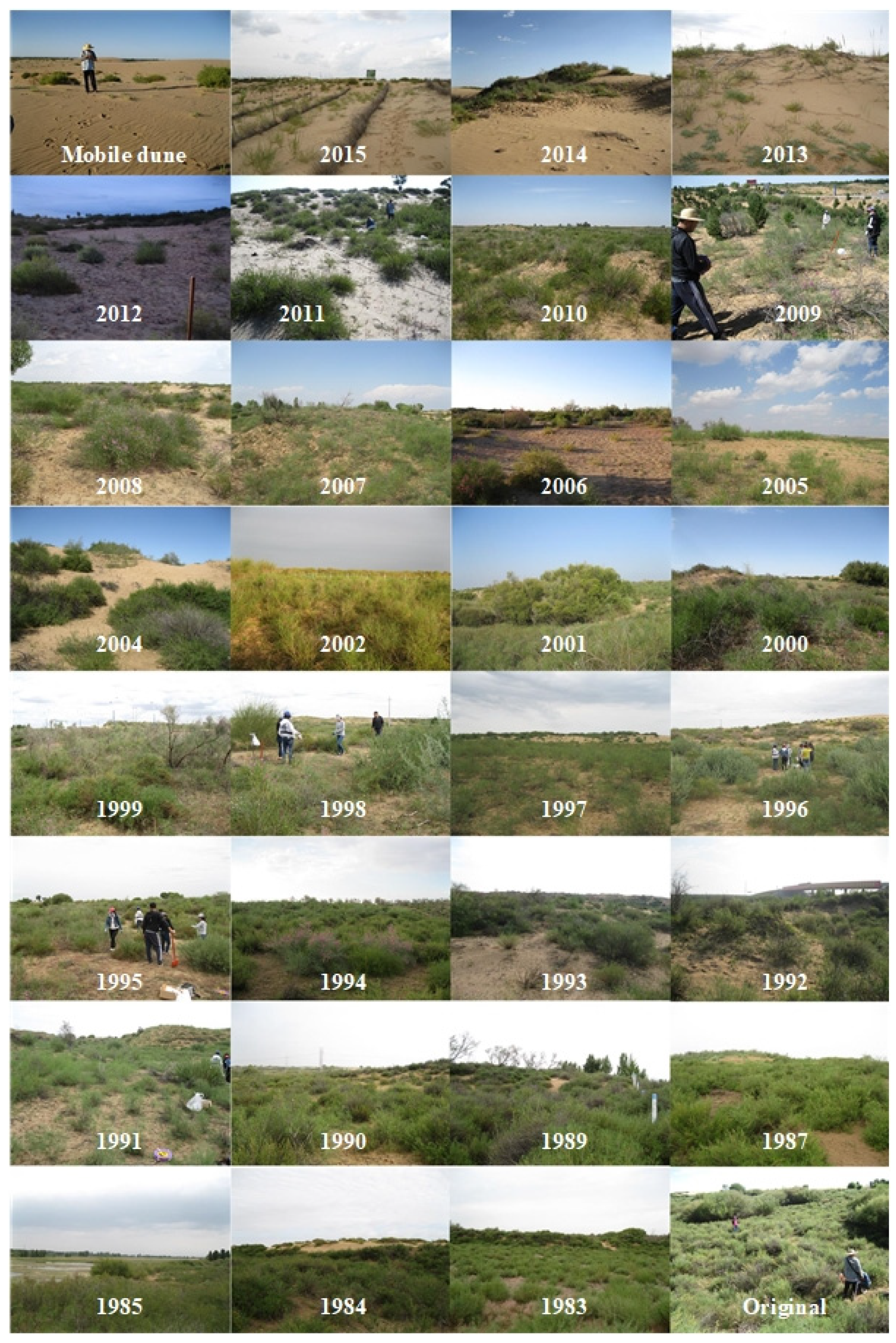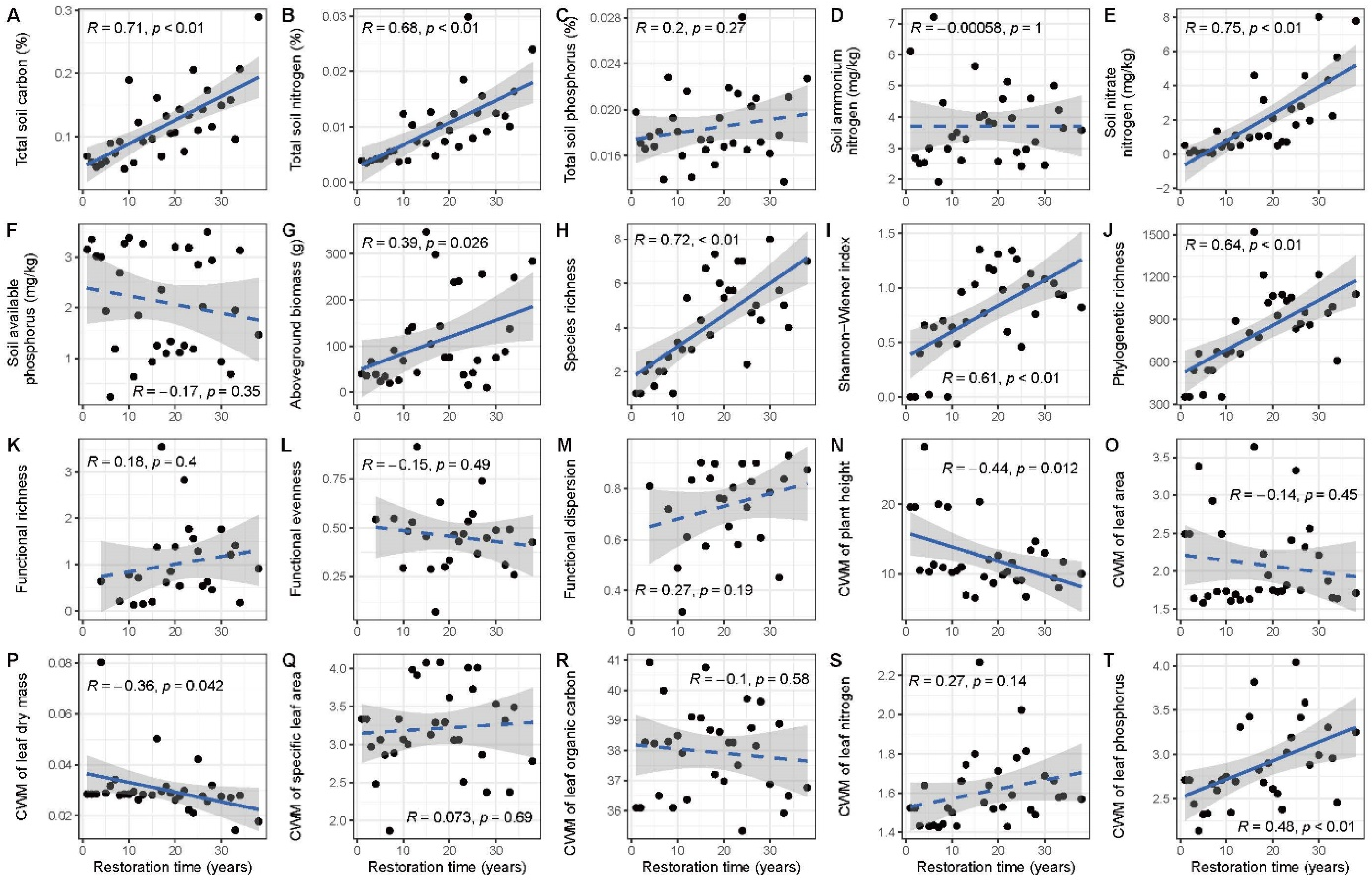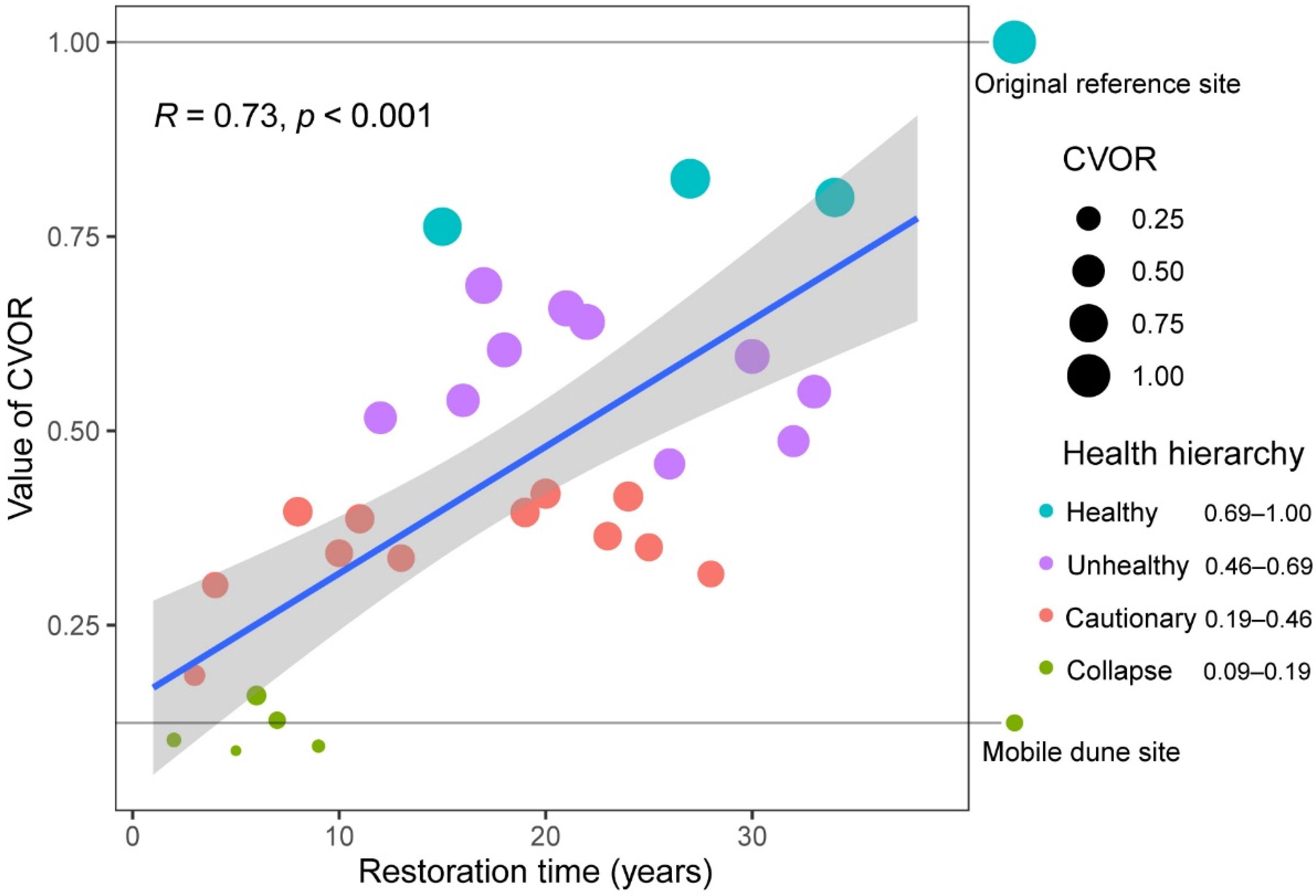Aerial Seeding Promotes the Restoration of Ecosystem Health in Mu Us Sandy Grasslands in China
Abstract
1. Introduction
2. Materials and Methods
2.1. Study Area
2.2. Data Sources
2.3. Data Analysis
2.3.1. The Establishment of an Evaluation Index System
2.3.2. Determination of Reference System
2.3.3. The Evaluation of Condition (C) Criterion Layers
2.3.4. The Evaluation of Vitality (V) Criterion Layers
2.3.5. The Evaluation of Organization (O) Criterion Layers
2.3.6. The Evaluation of Resilience (R) Criterion Layers
2.3.7. Determination of Weights of Indices in the COVR Model and Each Criterion Layer
2.3.8. Calculation of Plant Species, Phylogenetic, and Functional Diversity
2.3.9. Establishment of Grassland Ecosystem Health Hierarchy Standards
2.3.10. The Response of Indices in Each Criterion Layer and Grassland Ecosystem Health to the Restoration Time
3. Results
3.1. The Weights of Indices in the COVR Model and Each Criterion Layer
3.2. The Standards of Grassland Ecosystem Health Hierarchy
3.3. The Response of Indices in Each Criterion Layer to the Restoration Time
3.4. The Response of Grassland Ecosystem Health to the Restoration Time
4. Discussion
5. Conclusions
Author Contributions
Funding
Data Availability Statement
Conflicts of Interest
References
- Greenwood, K.; MacLeod, D.; Hutchinson, K. Long-term stocking rate effects on soil physical properties. Aust. J. Exp. Agric. 1997, 37, 413–419. [Google Scholar] [CrossRef]
- Guarda, V.A.; Guarda, R.D.A. Brazilian tropical grassland ecosystems: Distribution and research advances. Am. J. Plant Sci. 2014, 5, 924–932. [Google Scholar] [CrossRef][Green Version]
- Huang, X.; Yang, Y.; Chen, C.; Zhao, H.; Yao, B.; Ma, Z.; Ma, L.; Zhou, H. Quantifying and Mapping Human Appropriation of Net Primary Productivity in Qinghai Grasslands in China. Agriculture 2022, 12, 483. [Google Scholar] [CrossRef]
- Guo, Q.; Fu, B.; Shi, P.; Cudahy, T.; Zhang, J.; Xu, H. Satellite Monitoring the Spatial-Temporal Dynamics of Desertification in Response to Climate Change and Human Activities across the Ordos Plateau, China. Remote Sens. 2017, 9, 525. [Google Scholar] [CrossRef]
- UNCCD. The Ordos Declaration. UNCCD: Conference of the Parties: Thirteenth Session Ordos, China, 6–16 September 2017. 2017. Available online: http://www2.unccd.int/sites/default/files/inline-files/Ordos%20declaration.pdf (accessed on 13 July 2018).
- Li, M.M.; Liu, A.T.; Zou, C.J.; Xu, W.D.; Shimizu, H.; Wang, K.Y. An overview of the “Three-North” Shelterbelt project in China. For. Stud. China 2012, 14, 70–79. [Google Scholar] [CrossRef]
- Wu, Z.; Wu, J.; Liu, J.; He, B.; Lei, T.; Wang, Q. Increasing terrestrial vegetation activity of ecological restoration program in the Beijing–Tianjin Sand Source Region of China. Ecol. Eng. 2013, 52, 37–50. [Google Scholar] [CrossRef]
- Jia, X.; Fu, B.; Feng, X.; Hou, G.; Liu, Y.; Wang, X. The tradeoff and synergy between ecosystem services in the Grain-for-Green areas in Northern Shaanxi, China. Ecol. Indic. 2014, 43, 103–113. [Google Scholar] [CrossRef]
- Gao, X.H.; Wang, Y.M.; Wang, J.H.; Yan, C.Z.; Li, Z.F. Analysis on desertification dynamics based on remote sensing and GIS in zone along the Great Wall in northern Shaanxi province. J. Desert Res. 2005, 25, 63–67. [Google Scholar]
- Lee, B.J. An ecological comparison of the McHarg method with other planning initiatives in the Great Lakes Basin. Landsc. Plan. 1982, 9, 147–169. [Google Scholar] [CrossRef]
- Rapport, D.J. What constitutes ecosystem health? Perspect. Biol. Med. 1989, 33, 120–132. [Google Scholar] [CrossRef]
- Robert, C.; Bryan, G.N.; Benjamin, D.H. Ecosystem Health: New Goals for Environmental Management; Island Press: Washington, DC, USA, 1992. [Google Scholar]
- Toman, M. Special section: Forum on valuation of ecosystem services: Why not to calculate the value of the world’s ecosystem services and natural capital. Ecol. Econ. 1998, 25, 57–60. [Google Scholar] [CrossRef]
- Rapport, D.J.; Costanza, R.; McMichael, A.J. Assessing ecosystem health. Trends Ecol. Evol. 1998, 13, 397–402. [Google Scholar] [CrossRef]
- Hou, F.; Xu, L. History and current situation of ecosystem health research. Acta Prataculturae Sin. 2009, 18, 210–225. [Google Scholar]
- Ren, J.; Nan, Z.; Hao, D. The three major interfaces within pratacultural system. Acta Prataculturae Sin. 2000, 9, 1–8. [Google Scholar]
- Jiang, J.; Sun, B.; Pan, D.; Wang, H.; Li, X.; Wang, H.; Yu, H. VOR Index Based Health Assessment of Grassland Ecosystem in Sunan County. China Herbiv. Sci. 2020, 40, 39–43. [Google Scholar]
- Liu, Y.; Zhang, D.; Zhang, Y.; Shi, M.; Shang, Z.; He, L.; Zong, W.; Fu, H.; Niu, D. Evaluation of restoration effect in degraded alpine meadow under different regulation measures. Trans. Chin. Soc. Agric. Eng. 2016, 32, 268–275. [Google Scholar]
- Liu, Q.; Zhang, Q.; Yan, Y.; Zhang, X.; Niu, J.; Svenning, J.C. Ecological restoration is the dominant driver of the recent reversal of desertification in the Mu Us Desert (China). J. Clean. Prod. 2020, 268, 122241. [Google Scholar] [CrossRef]
- Liu, Q.; Zhang, Q.; Jarvie, S.; Yan, Y.; Han, P.; Liu, T.; Guo, K.; Ren, L.; Yue, K.; Wu, H.; et al. Ecosystem restoration through aerial seeding: Interacting plant–soil microbiome effects on soil multifunctionality. Land Degrad. Dev. 2021, 32, 5334–5347. [Google Scholar] [CrossRef]
- Webb, C.O.; Ackerly, D.D.; Kembel, S.W. Phylocom: Software for the analysis of phylogenetic community structure and trait evolution. Bioinformatics 2008, 24, 2098–2100. [Google Scholar] [CrossRef]
- Zanne, A.E.; Tank, D.C.; Cornwell, W.K.; Eastman, J.M.; Smith, S.A.; FitzJohn, R.G.; McGlinn, D.J.; O’Meara, B.C.; Moles, A.T.; Reich, P.B.; et al. Three keys to the radiation of angiosperms into freezing environments. Nature 2014, 506, 89–92. [Google Scholar] [CrossRef]
- Qian, H.; Jin, Y. An updated megaphylogeny of plants, a tool for generating plant phylogenies and an analysis of phylogenetic community structure. J. Plant Ecol. 2015, 9, 233–239. [Google Scholar] [CrossRef]
- Zirbel, C.R.; Grman, E.; Bassett, T.; Brudvig, L.A. Landscape context explains ecosystem multifunctionality in restored grasslands better than plant diversity. Ecology 2019, 100, e02634. [Google Scholar] [CrossRef]
- Hobbs, R.J.; Norton, D.A. Towards a conceptual framework for restoration ecology. Restor. Ecol. 1996, 4, 93–110. [Google Scholar] [CrossRef]
- Wang, L.X.; Liu, Z.L.; Liu, H.M.; Wang, W.; Liang, C.; Qiao, J.; Nobukazu, N. Assessment of typical steppe ecosystem health in Inner Mongolia. Acta Ecol. Sin. 2008, 28, 543–550. [Google Scholar]
- Shan, G.L.; Jiang, H.; Yan, W.H.; Liu, Z.I.; Luo, F.C.; Duan, X.H.; Chu, X.H. VOR and CVOR index for health evaluation of typical steppe in Inner Mongolia. Anim. Husb. Feed Sci. 2012, 4, 266. [Google Scholar]
- Sterk, M.; Gort, G.; Klimkowska, A.; Van Ruijven, J.; Van Teeffelen, A.J.; Wamelink, G.W. Assess ecosystem resilience: Linking response and effect traits to environmental variability. Ecol. Indic. 2013, 30, 21–27. [Google Scholar] [CrossRef]
- Zou, Z.-H.; Yi, Y.; Sun, J.-N. Entropy method for determination of weight of evaluating indicators in fuzzy synthetic evaluation for water quality assessment. J. Environ. Sci. 2006, 18, 1020–1023. [Google Scholar] [CrossRef]
- Kembel, S.W.; Cowan, P.D.; Helmus, M.R.; Cornwell, W.K.; Morlon, H.; Ackerly, D.D.; Blomberg, S.P.; Webb, C.O. Picante: R tools for integrating phylogenies and ecology. Bioinformatics 2010, 26, 1463–1464. [Google Scholar] [CrossRef]
- Laliberté, E.; Legendre, P. A distance-based framework for measuring functional diversity from multiple traits. Ecology 2010, 91, 299–305. [Google Scholar] [CrossRef]
- Van Niekerk, L.; Adams, J.B.; Bate, G.C.; Forbes, A.T.; Forbes, N.T.; Huizinga, P.; Lamberth, S.J.; MacKay, C.F.; Petersen, C.; Taljaard, S.; et al. Country-wide assessment of estuary health: An approach for integrating pressures and ecosystem response in a data limited environment. Estuar. Coast. Shelf Sci. 2013, 130, 239–251. [Google Scholar] [CrossRef]
- Shi, G.; Zhang, J.; Yao, L.; Zhao, Y.; Ding, Y.; Zhang, Q. Construction of Grassland Ecosystem Health Evaluation System in Inner Mongolia: Based on the Formation, Vegetation Subtype and Vegetation Type. J. Inn. Mong. Univ. (Nat. Sci. Ed.) 2021, 53, 55–65. [Google Scholar]
- Wan, S.; Xia, J.; Liu, W.; Niu, S. Photosynthetic overcompensation under nocturnal warming enhances grassland carbon sequestration. Ecology 2009, 90, 2700–2710. [Google Scholar] [CrossRef] [PubMed]
- Liu, X.-Y.; Mu, Y.-T. Research progress in the ecosystem services function and value of grasslands. Acta Prataculturae Sin. 2012, 21, 286. [Google Scholar]
- Pennekamp, F.; Pontarp, M.; Tabi, A.; Altermatt, F.; Alther, R.; Choffat, Y.; Fronhofer, E.A.; Ganesanandamoorthy, P.; Garnier, A.; Griffiths, J.I.; et al. Biodiversity increases and decreases ecosystem stability. Nature 2018, 563, 109–112. [Google Scholar] [CrossRef]
- Novoa, R.; Loomis, R. Nitrogen and plant production. Plant Soil 1981, 58, 177–204. [Google Scholar] [CrossRef]
- Torres-Olivar, V.; Villegas-Torres, O.G.; Domínguez-Patiño, M.L.; Sotelo-Nava, H.; Rodríguez-Martínez, A.; Melgoza-Alemán, R.M.; Valdez-Aguilar, L.A.; Alia-Tejacal, I. Role of nitrogen and nutrients in crop nutrition. J. Agric. Sci. Technol. B 2014, 4, 29. [Google Scholar]
- Ma, Q.; Xu, M.; Liu, M.; Cao, X.; Hill, P.W.; Chadwick, D.R.; Wu, L.; Jones, D.L. Organic and inorganic sulfur and nitrogen uptake by co-existing grassland plant species competing with soil microorganisms. Soil Biol. Biochem. 2022, 168, 108627. [Google Scholar] [CrossRef]
- Elrys, A.S.; Chen, Z.; Wang, J.; Uwiragiye, Y.; Helmy, A.M.; Desoky, E.S.; Cheng, Y.; Zhang, J.B.; Cai, Z.C.; Müller, C. Global patterns of soil gross immobilization of ammonium and nitrate in terrestrial ecosystems. Glob. Change Biol. 2022, 28, 4472–4488. [Google Scholar] [CrossRef]
- Hao, D.L.; Zhou, J.Y.; Yang, S.Y.; Qi, W.; Yang, K.J.; Su, Y.H. Function and regulation of ammonium transporters in plants. Int. J. Mol. Sci. 2020, 21, 3557. [Google Scholar] [CrossRef]
- Stockmann, U.; Adams, M.A.; Crawford, J.W.; Field, D.J.; Henakaarchchi, N.; Jenkins, M.; Minasny, B.; McBratney, A.B.; De Courcelles, V.D.; Singh, K.; et al. The knowns, known unknowns and unknowns of sequestration of soil organic carbon. Agric. Ecosyst. Environ. 2013, 164, 80–99. [Google Scholar] [CrossRef]
- Petchey, O.L.; Gaston, K.J. Functional diversity: Back to basics and looking forward. Ecol. Lett. 2006, 9, 741–758. [Google Scholar] [CrossRef]
- Valencia, E.; Maestre, F.T.; Le Bagousse-Pinguet, Y.; Quero, J.L.; Tamme, R.; Börger, L.; García-Gómez, M.; Gross, N. Functional diversity enhances the resistance of ecosystem multifunctionality to aridity in M editerranean drylands. New Phytol. 2015, 206, 660–671. [Google Scholar] [CrossRef]




| Criterion Layers | Indexes | |
|---|---|---|
| Sandy grassland ecosystem health evaluation (CVOR) | Condition (C) | Total soil carbon (TC) |
| Total soil nitrogen (TN) | ||
| Total soil phosphorus (TP) | ||
| Soil ammonium nitrogen (NH4+) | ||
| Soil nitrate nitrogen (NO3−) | ||
| Soil available phosphorus (AP) | ||
| Vitality (V) | Aboveground biomass (AB) | |
| Organization (O) | Species richness index (S) | |
| Shannon–Wiener index (H′) | ||
| Phylogenetic richness (P) | ||
| Functional Richness (FRic) | ||
| Functional Evenness (FEve) | ||
| Functional Dispersion (FDis) | ||
| Resilience (R) | Community-weighted mean of H (CWMH) | |
| Community-weighted mean of LA (CWMLA) | ||
| Community-weighted mean of LDM (CWMLDM) | ||
| Community-weighted mean of SLA (CWMSLA) | ||
| Community-weighted mean of LOC (CWMLOC) | ||
| Community-weighted mean of LN (CWMLN) | ||
| Community-weighted mean of LP (CWMLP) |
| Weights of Indices in the COVR Model | Weights of Indices in Each Criterion Layer | ||
|---|---|---|---|
| Condition (C) | WC = 0.288 | Total soil carbon (TC) | WTC = 0.121 |
| Total soil nitrogen (TN) | WTN = 0.180 | ||
| Total soil phosphorus (TP) | WTP = 0.012 | ||
| Soil ammonium nitrogen (NH4+) | WNH4+ = 0.631 | ||
| Soil nitrate nitrogen (NO3−) | WNO3− = 0.015 | ||
| Soil available phosphorus (AP) | WAP = 0.041 | ||
| Vitality (V) | WV = 0.476 | Aboveground biomass (AB) | WAB = 1.000 |
| Organization (O) | WO = 0.234 | Species richness index (S) | WS = 0.115 |
| Shannon–Wiener index (H′) | WH′ = 0.135 | ||
| Phylogenetic richness (P) | WP = 0.046 | ||
| Functional Richness (FRic) | WFRic = 0.250 | ||
| Functional Evenness (FEve) | WFEve = 0.257 | ||
| Functional Dispersion (FDis) | WFDis = 0.197 | ||
| Resilience (R) | WR = 0.002 | Community-weighted mean of H (CWMH) | WCWM-H = 0.344 |
| Community-weighted mean of LA (CWMLA) | WCWM-LA = 0.015 | ||
| Community-weighted mean of LDM (CWMLDM) | WCWM-LDM = 0.153 | ||
| Community-weighted mean of SLA (CWMSLA) | WCWM-SLA = 0.036 | ||
| Community-weighted mean of LOC (CWMLOC) | WCWM-LOC = 0.002 | ||
| Community-weighted mean of LN (CWMLN) | WCWM-LN = 0.037 | ||
| Community-weighted mean of LP (CWMLP) | WCWM-LP = 0.413 | ||
| The Value of CVOR | Health Hierarchy |
|---|---|
| 0.69–1.00 | Healthy |
| 0.46–0.69 | Unhealthy |
| 0.19–0.46 | Cautionary |
| 0.09–0.19 | Collapse |
Publisher’s Note: MDPI stays neutral with regard to jurisdictional claims in published maps and institutional affiliations. |
© 2022 by the authors. Licensee MDPI, Basel, Switzerland. This article is an open access article distributed under the terms and conditions of the Creative Commons Attribution (CC BY) license (https://creativecommons.org/licenses/by/4.0/).
Share and Cite
Ma, Y.; Wang, S.; Zhang, Q.; Guo, K.; He, Y.; Chen, D.; Sui, M.; Zhang, G.; Zang, L.; Liu, Q. Aerial Seeding Promotes the Restoration of Ecosystem Health in Mu Us Sandy Grasslands in China. Agriculture 2022, 12, 1255. https://doi.org/10.3390/agriculture12081255
Ma Y, Wang S, Zhang Q, Guo K, He Y, Chen D, Sui M, Zhang G, Zang L, Liu Q. Aerial Seeding Promotes the Restoration of Ecosystem Health in Mu Us Sandy Grasslands in China. Agriculture. 2022; 12(8):1255. https://doi.org/10.3390/agriculture12081255
Chicago/Turabian StyleMa, Yina, Shixiong Wang, Qing Zhang, Kun Guo, Yuejun He, Danmei Chen, Mingzhen Sui, Guangqi Zhang, Lipeng Zang, and Qingfu Liu. 2022. "Aerial Seeding Promotes the Restoration of Ecosystem Health in Mu Us Sandy Grasslands in China" Agriculture 12, no. 8: 1255. https://doi.org/10.3390/agriculture12081255
APA StyleMa, Y., Wang, S., Zhang, Q., Guo, K., He, Y., Chen, D., Sui, M., Zhang, G., Zang, L., & Liu, Q. (2022). Aerial Seeding Promotes the Restoration of Ecosystem Health in Mu Us Sandy Grasslands in China. Agriculture, 12(8), 1255. https://doi.org/10.3390/agriculture12081255







